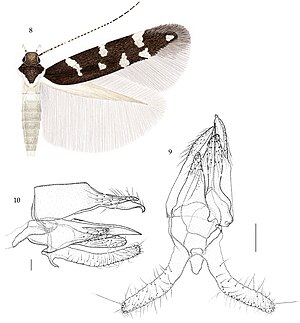Vulcaniella
| Vulcaniella | ||||||||||
|---|---|---|---|---|---|---|---|---|---|---|

|
||||||||||
| Systematics | ||||||||||
|
||||||||||
| Scientific name | ||||||||||
| Vulcaniella | ||||||||||
| Riedl , 1965 |
Vulcaniella is a genus of butterflies from the family of cosmopterigidae (Cosmopterigidae).
features
The representatives of the genus are small butterflies with smoothly scaled heads. The antennae are three quarters to four fifths as long as the forewings. The labial palps are cylindrical and elongated, the third segment is strongly curved upwards and often extends well above the head. The forewings are lanceolate and clearly constricted subapically in the females of some species . The basic color ranges from black-brown to dark brown to golden brown and the pattern consists of white, silvery or pale gold bands and spots. The hind wings are very narrow.
In the males, the tegumen is well developed and square. The rear end has a deep bulge. The brachia are asymmetrical. The right brachium is longer than the left and often has a broadened tip. The blades are narrow and elongated and have sparsely bristles distally . The right valvella is well developed while the left is greatly reduced and fused with the aedeagus . The aedeagus is bulged in the middle, the distal part is pointed. The cecum penis is short and tubular, cornuti are not formed. The praises of the 8th segment are rounded.
In the females, the Apophyses posteriores are about one and a half times as long as the Apophyses anteriores. The sterigma with the characteristically sclerotized anterior vaginal plate is opposite the sclerotization at the posterior end of the 7th sternite . The bursal duct is long, narrow, and membranous, with occasional sclerotic spots on the distal side. The corpus bursae is oval to elongated. There are two funnel-shaped, inwardly directed signs, which are often surrounded by strong, circular wrinkles.
distribution
The species of the genus Vulcaniella are native to the Palearctic . In Europe, most of the species are found in the Mediterranean region.
biology
The caterpillars live as leaf miners on mint family (Lamiaceae) and daisy family (Asteraceae).
Systematics
The following list of species is based on the World catalog of cosmopterigid moths created by Sinev in 2002 and has been supplemented or corrected with additional species. The type species of the genus is Elachista pomposella Zeller , 1839.
- Vulcaniella anatolica Koster & Sinev , 2003 - Turkey
- Vulcaniella caucasica Sinev , 1986 - Azerbaijan
- Vulcaniella cognatella Riedl , 1990 - Turkey
- Vulcaniella extremella ( Wocke , 1871) - Croatia
- Vulcaniella fiordalisa ( Petty , 1904) - Corsica
- Vulcaniella gielisi Koster & Sinev , 2003 - Spain
- Vulcaniella glaseri ( Riedl , 1966) - Turkey
- Vulcaniella grabowiella ( Staudinger , 1859) - Spain
- Vulcaniella grandiferella Sinev , 1986 - Russia
- Vulcaniella kabulensis Koster , 2008 - Afghanistan
- Vulcaniella karadaghella Sinev , 1986 - Ukraine
- Vulcaniella klimeschi ( Riedl , 1966) - Macedonia
- Vulcaniella kopetdaghella Sinev , 1986 - Turkmenistan
- Vulcaniella peristrepta ( Meyrick , 1917) - Pakistan
- Vulcaniella pomposella ( Zeller , 1839) - Germany
- Vulcaniella pontica Koster & Sinev , 2003 - Turkey
- Vulcaniella rosmarinella ( Walsingham , 1891) - France
- Vulcaniella schultzendorffi ( Amsel , 1958) - Iran
- Vulcaniella vartianae ( Blackbird , 1968) - Pakistan
supporting documents
- ↑ a b c d e f J. C. Koster, S. Yu. Sinev: Momphidae, Batrachedridae, Stathmopodidae, Agonoxenidae, Cosmopterigidae, Chrysopeleiidae . In: P. Huemer, O. Karsholt, L. Lyneborg (eds.): Microlepidoptera of Europe . 1st edition. tape 5 . Apollo Books, Stenstrup 2003, ISBN 87-88757-66-8 , pp. 151 (English).
- ↑ S. Yu. Sinev (2002): World catalog of cosmopterigid moths (Lepidoptera: Cosmopterigidae). Proceedings of the Zoological Institute, St. Petersburg, Volume 293, pp. 157-159
- ↑ JC Koster (2008): Notes on the Cosmopterigidae (Lepidoptera) of Afghanistan and Jammu & Kashmir, India with descriptions of two new species. Zoological Mededelingen Leiden 82: p. 97.
- ^ Vulcaniella at Fauna Europaea. Retrieved February 28, 2012